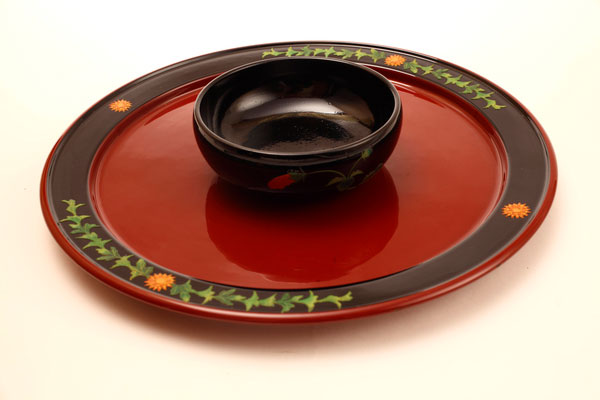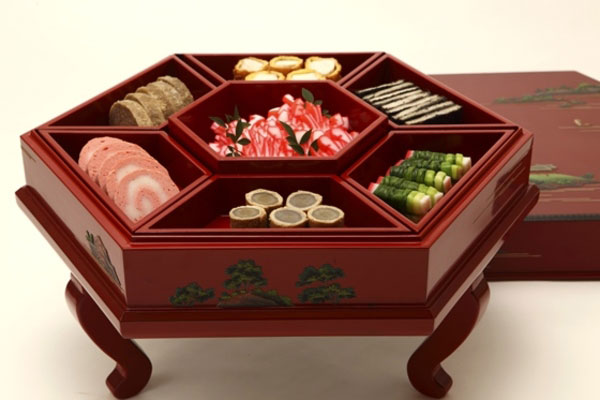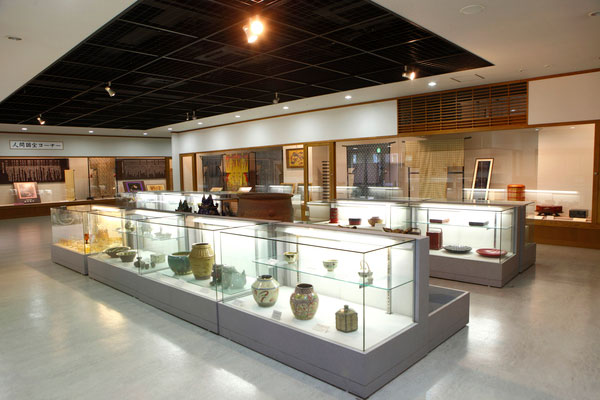 Photo:Okinawa Convention&Visitors Bureau
Photo:Okinawa Convention&Visitors Bureau
- Lacquerware
- Okinawa
Ryukyu lacquerware Ryukyu shikki
Splendor engraving the history of foreign trade
Beautiful flower coating using vermillion and black lacquer
Description
What is Ryukyu lacquerware ?
Ryukyu lacquerware (called Ryukyu shikki in Japanese) is produced in Okinawa prefecture. Lacquerware techniques imported from China were well-adapted during the development of Ryukyu lacquerware unique to Okinawa. The technology and artistry involved in this craft is praised not only in Japan, but also overseas.
This lacquerware has a great diversity of decorating techniques. Tsuikin (lacquer overlay), a uniquely Okinawan decoration technique, is based on a Chinese style called tsuishu (red lacquerware with raised designs) and gives items a three-dimensional appearance. Another popular technique is hananuri which has a contrast between traditional vermillion lacquer and black lacquer, creating a vivid brilliance. Alternative techniques are chinkin (gold inlaying), haku-e (foil lacquering) and raden (seashell flake inlaying).
Okinawa is greatly blessed with climatic conditions that are ideal for the production of lacquer, as it is possible to collect high-quality raw materials like Indian coral tree, Japanese snowbell, and Okinawan banyan tree. Ryukyu lacquerware has set itself apart due to favorable conditions as a production area and the great efforts of its artisans.
History
 Photo:Okinawa Convention&Visitors Bureau
Photo:Okinawa Convention&Visitors Bureau
The history of Ryukyu lacquerware goes back to the 14th and 15th centuries, when Okinawa was the Ryukyu Kingdom. Trade with China was prosperous, so the techniques of lacquerware were brought from there.
In the 15th century, after the Ryukyu Kingdom became united, the Mother-of-Pearl Magistrate's Office was established in order to produce more lacquerware. In the Ryukyu region, where politics and faith were closely connected, lacquer ornaments and beaded necklaces were used in religious services and ceremonies. The descendents of Ryukyu samurai and royalty used lacquerware in formal places in order to forge a connection between people and gods.
When the Satsuma domain invaded the Ryukyu Kingdom in 1609, Ryukyu lacquerware was confiscated and presented to the lord, Ieyasu TOKUGAWA. With the advances of the Satsuma domain, diplomatic ties with Japan became stronger than ties with China.
Ryukyu lacquerware in the 16th to 17th centuries focused on the production of chinkin (gold inlaying) items with vermillion and green lacquer, and raden (seashell flake inlaying) articles with red lacquer. In the 17th to 18th centuries, there was a shift to finely detailed raden pieces using green turban (marine snail) shell on black lacquer. Then, during the 18th to 19th centuries, techniques such as chinkin (gold inlaying), haku-e (foil lacquering) and tsuikin (red lacquerware with raised designs) came to be used. With the annexation of the Ryukyu Kingdom and establishment of Okinawa prefecture in 1879, Ryukyu lacquerware started to be produced by private workshops and lacquerware companies.
General Production Process
- 1. Wood base production
Ryukyu lacquerware mainly uses joinery wood bases for the production of stacked boxes and serving trays or lathe turned wood bases for the production of bowls and trays. Wood that has been dried for approximately six months is used.
Joinery wood base production is the process of applying adhesive to a board, assembling pieces, drying, and then forming an item by cutting with a hand plane.
Lathe turned wood base production uses either vertical sawing, with wood cut into round slices, or horizontal sawing, with wood cut lengthways.
- 2. Undercoating
Surface scratches, cracks, and small holes are carefully covered with an undercoating of niibi sand, a mixture of small-grain sandstone and raw lacquer. This is ideal for coating coarse wood from the Indian coral tree. Then an undercoating of kucha, a mixture of mudstone powder and raw lacquer, is applied and finally the articles are dried.
- 3. Wet polishing
This process involves grinding with a grindstone or sandpaper while applying water. Starting with rougher paper, the articles are scoured while gradually switching to finer paper. This step is repeated several times between undercoating and lacquering.
- 4. Intermediate coating
In order to improve the finish of the overcoating, lacquer mixed with a pigment the same color as the overcoating is applied.
- 5. Overcoating
Infrared or ultraviolet rays are applied to the raw lacquer and moisture is evaporated in a process called kurome, producing transparent lacquer. A thick mixture of lacquer and vermillion colorant is filtered with Japanese paper to produce lacquer for overcoating.
Each piece is carefully coated using a wide paintbrush as this step is what the condition of the item is judged by. The finish of the lacquerware is affected by the temperature and weather at the time of coating, so it is essential that the artisan has a great expertise. Fine dust and air bubbles are carefully removed using a thin needlelike object and then the items are left to dry. They are then placed inside a rotating bath, where it must be ensured that lacquer does not drip, while being rotated up and down. Based on the atmospheric temperature when drying the lacquer, the color may be darkened or the lacquer may contract, so the level of humidity must be regulated carefully.
- 6. Decoration
There is a wide variation of decorating techniques for Ryukyu lacquerware.
The first one is raden, a form of decoration using green turban or abalone. Shells are cut into thin pieces, which are patterned using a silkwork needle then affixed to the vessel, on top of which lacquer is applied. With this technique, once the lacquer has dried, polishing is done with a mixture of charcoal and polishing powder until the shells are visible, and finally glaze made with powder produced from deer antlers is applied.
The embedding of gold leaf in engraved lines is called chinkin. With this technique, a raised pattern is line-engraved onto the vessel using a knife and lacquer is rubbed into the design. Then gold leaf is applied on top of the lacquer while it is still wet, and after it dries, gold leaf will remain in the design.
For the haku-e technique, pictures drawn onto vessels are outlined with red iron oxide lacquer, after which the inside of the pattern is coated and gold leaf is pasted when the item is partially dried. This technique leaves a golden pattern when excess gold leaf is removed with a brush. Once the article has completely dried, black lacquer is used to outline the pictures and then it is complete.
Lastly, there is a technique unique to Ryukyu lacquerware called tsuikin where a pattern is cut from a pigmented lacquer sheet which is then pasted on the item. Then the rest of the piece is carved and colored.
Where to Buy & More Information
Naha Traditional Craft Center
 Photo:Okinawa Convention&Visitors Bureau
Photo:Okinawa Convention&Visitors Bureau
-
Address
-
Tel.+81-98-868-7866
-
ClosedWednesdays and December 29 to January 3
-
Business Hours9:30am to 5:30pm
-
Website
See more Lacquerware
- Wajima lacquerware
- Kamakura-bori lacquerware
- Tsugaru lacquerware
- Aizu lacquerware
- Yamanaka lacquerware
- Kawatsura lacquerware
- Echizen lacquerware
- Joboji lacquerware
- Kiso lacquerware
- Hidehira lacquerware
- Kagawa lacquerware
- Ryukyu lacquerware
- Takaoka lacquerware
- Wakasa lacquerware
- Hida-shunkei lacquerware
- Ouchi lacquerware
- Kanazawa lacquerware
- Kishu lacquerware
- Kyo laquerware
- Odawara lacquerware
- Naruko lacquerware
- Niigata lacquerware
- Murakami carved lacquerware
See items made in Okinawa
- Tsuboya ware
- Miyako ramie textile
- Ryukyu lacquerware
- Kumejima tsumugi silk
- Ryukyu traditional resist-dyed textiles
- Chibana-hanaori textiles
- Yaeyama cotton cloth
- Yaeyama ramie cloth
- Shuri brocade
- Yomitanzan-hanaori textiles
- Ryukyu traditional textiles
- Kijoka banana fiber cloth
- Yonaguni brocade
- Yuntanza minsa
- Flower pattern textiles
- Sanshin































































































































































































































































































